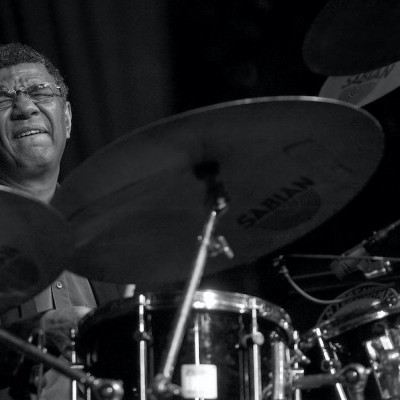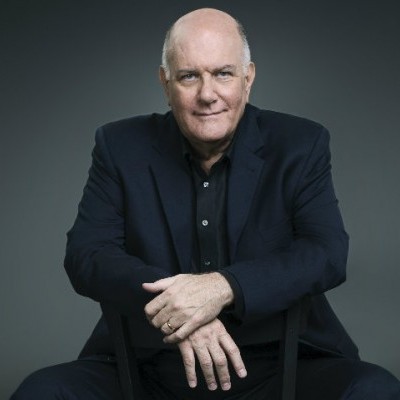Oct 28, 2025 10:47 AM
In Memoriam: Jack DeJohnette, 1942–2025
Jack DeJohnette, a bold and resourceful drummer and NEA Jazz Master who forged a unique vocabulary on the kit over his…
Pianist and writer Ben Sidran is set to release The Ballad of Tommy LiPuma (Nardis Books), a work that covers the producer’s career alongside luminaries like Miles Davis, Dr. John, The O’Jays, Barbra Streisand and George Benson. The book is due out May 5 in print and as an e-book. For more information, visit the Nardis website.
An excerpt of the book that touches on LiPuma’s time with trumpeter and composer Miles Davis is below.
“I had never heard anything but horrible stories about how hard it was to work with Miles,” says Tommy. “My first thought was that I wasn’t sure I wanted to do it. But how can you turn down Miles Davis? And when I walked into Miles’s dressing room in Montreux, he was very cordial, and after we had a nice chat I told him, ‘Hey, man, I’m going to split after the show, but when you’re back in New York let’s get together.’ I relied on the business affairs people to deal with the details, and I went about planning how to make a Miles Davis record that could bring him back into the greater popular consciousness. He had more or less been missing since his so-called hiatus in the late 1970s.”
This was around the time that Miles had begun sketching, seriously, not just to amuse himself but with an eye on the extension of his own artistic expression. Everywhere he went, he carried a pad and pens with him. When he walked into Tommy’s apartment a few weeks later and saw all the art on the walls, even though he was wearing dark shades, he went straight to a painting by [Alfred Henry] Maurer and said, “Man, who is this cat?” Art was the icebreaker.
Then they sat down and started listening to music. Says Tommy, “I played him a Scritti Politti thing and he liked where I was going. We talked about how the recording might go down, and I mentioned that I had been working with Marcus Miller and I was thinking of having him involved, and his response was, ‘Yeah, I love Marcus.’ This was when drum machines were just starting to arrive on the scene, and Marcus was one of the few cats who really knew how to program them so they didn’t sound mechanical.
“Miles kept looking at all this art and listening to this music I was playing him, and just as we were leaving, he finally took his glasses off and put them up on his forehead. He had the blackest eyes you can imagine: pitch black. When he looked at you, it felt like he was staring straight through you. He grabbed me by both shoulders and he looked me right in the eye. He didn’t say a thing, but I understood: He was saying, ‘Yeah, alright. Let’s do this.’ I passed his test.” It was the first day of a friendship that lasted until the day Miles died.
The morning of the first recording session for Miles’ album [Tutu], Marcus walked in with a drum machine, set it on the desk, connected it to the console, and played down this thing he had programmed. “I don’t know how he did it,” says Tommy, “but somehow he made this drum machine feel like it was swinging.” Normally drum machines felt like what they were, machines—too perfect in their subdivision of time—but this program had a kind of triplet feel that made it seem more human. First, they put the drum pattern down on tape and then Marcus went in and did his bass part. After that, he did a couple of keyboard parts. And what emerged was the track for “Tutu.”
The next day, Miles came in and played on top of it. After three or four takes, Miles said that was it and packed up his horn. “I didn’t realize how ill he was at the time,” says Tommy. “He was exhausted after an hour. I said, ‘That’s cool, Miles,’ and he split. We listened to all the different takes we had and started to build a complete melody and solo. When we finished, I had a cassette made and went for a ride in my car. I drove from Vine Street all the way to the beach and back to my hotel in Hollywood just listening to this one performance over and over, because I couldn’t believe how great it was. He was all over the horn with total confidence.”
Tommy called Miles the next morning and said, “Man, do you have any idea what we got here?” Miles said, “Man, I’m so tired,” and he canceled the session for later that day. But before he hung up, he told Tommy something Tommy would never forget. Talking about what he had played, Miles told Tommy, “Man, it’s just the blues. Everything emanates from the blues.” From that point on, Tommy just kept saying to himself, “I can’t believe this is happening.” He was hearing Miles, one of his heroes, playing like he hadn’t played in years, deep into the blues.
Tutu is the only record Tommy produced that relied on a drum machine. “My feeling,” says Tommy, “is that when these new toys come out, everybody starts using them on everything, and it becomes a fashion statement instead of a tool; knowing when to use it and more importantly when not to use it is the key. At the time, a lot of hit songs were based on rhythm patterns coming out of the way these machines could be programmed. I like things to breathe, and drum machines don’t usually sound like they’re breathing.”
But Miles didn’t mind playing to the drum machine. He was able to groove with it. “With Miles,” says Tommy, “there was no gray area. He either felt comfortable or he didn’t. He didn’t grow into things. Everything with this guy was right at the moment. His heart was on his sleeve. Nothing about him was premeditated. This was one of the things about being around him that I loved; he was the way he played.”
The last time Tommy saw Miles was when Miles was in the hospital, not long before he died. “He called me up and said, ‘Tommy, I got something I want to play for you.’ I went to see him and he was in this bed with all kinds of stuff around him, tapes and drawing materials. He put in this cassette of something he had been working on. When it was over, I said, ‘Yeah, Miles, that’s nice. I think maybe you could ...’ and he interrupted me right there. He said, ‘I don’t want to know what you think about it. I just wanted to play it for you.’”
“I really miss the man,” says Tommy. “There was absolutely nobody like him.” DB

Jack DeJohnette boasted a musical resume that was as long as it was fearsome.
Oct 28, 2025 10:47 AM
Jack DeJohnette, a bold and resourceful drummer and NEA Jazz Master who forged a unique vocabulary on the kit over his…

Always a sharp dresser, Farnsworth wears a pocket square given to him by trumpeter Art Farmer. “You need to look good if you want to hang around me,” Farmer told him.
Sep 23, 2025 11:12 AM
When he was 12 years old, the hard-swinging veteran drummer Joe Farnsworth had a fateful encounter with his idol Max…

D’Angelo achieved commercial and critical success experimenting with a fusion of jazz, funk, soul, R&B and hip-hop.
Oct 14, 2025 1:47 PM
D’Angelo, a Grammy-winning R&B and neo-soul singer, guitarist and pianist who exerted a profound influence on 21st…

Kandace Springs channeled Shirley Horn’s deliberate phrasing and sublime self-accompaniment during her set at this year’s Pittsburgh International Jazz Festival.
Sep 30, 2025 12:28 PM
Janis Burley, the Pittsburgh International Jazz Festival’s founder and artistic director, did not, as might be…

Jim McNeely’s singular body of work had a profound and lasting influence on many of today’s top jazz composers in the U.S. and in Europe.
Oct 7, 2025 3:40 PM
Pianist Jim McNeely, one of the most distinguished large ensemble jazz composers of his generation, died Sept. 26 at…